‘The Borgias , The Most Infamous Family in History.’
a lecture By Sarah Dunant, Art historian and author.
Sarah produced a most interesting and amusing lecture, using her skills as an author to paint pictures in our minds about the Borgias, during a highly political time in Italy. ‘What is truth,’ she asked, ‘victors write history’. She embarked on a talk which involved corruption, creativity, and the Church.
She set the scene with the election of Rodrigo Borgia, (Borja- Spanish spelling) an outsider from Valencia, who wanted to be appointed as Pope. He had been to University and worked for five Popes, gaining considerable experience. The cardinals were kept in a conclave within the Sistine Chapel for five days until a choice was made. Each had a cell, a desk, a chair and a pallet, there were no servants, no luxuries. On the walls were frescoes of ‘drapes’ and above on the left was the ‘Life of Moses’ by Botticelli and on the other side, more drapes was a tableau of Jesus handing the keys to St.Peter, the first vicar of Christ, painted by Perogino.
Finally, Rodrigo Borgia was appointed to become Pope Alexander VIth, but it took six mules, laden with silver, for one of his opponents, to secure the deal.
The Pope had little territorial land but his position in the church carried great weight, he was called upon to crown the head of the Roman Empire and enable King Henry Tudor to annul his marriage.
Rodrigo installed his mistress, Guilia Farnese, in the Vatican, he was 56 years old and she, a mere 15 years old.
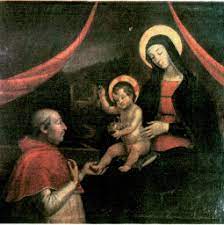
This painting of the Pope, Mary, and child Jesus. No longer exists. Mary was said to have the likeness of Guilia.
He married her off to his nephew and she had two children. Before Guilia, Borgia had an affair with Vannozza dei Cattenei, and had four illegitimate children by her : Cesare (1475) , Giovanni (1476), Lucrezia (1480), and Gioffre (1481). He set great store by them.
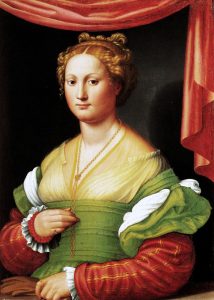
Portrait of Vanozza dei Cattenei
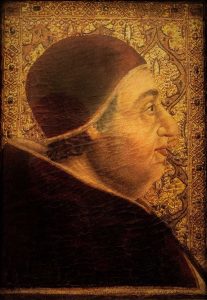
Portrait of Pope Alexande VI attributed to Pedro Berruguete
The Pope celebrated his appointment by throwing parties and getting his apartments decorated by Pinturriccio. The frescoes included portraits of members of his family.
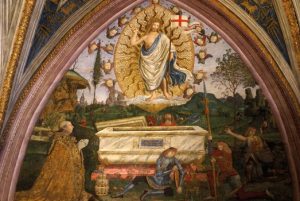
The Resurrection by Pinturiccio
If you look carefully at this painting, you will see some figures in the background, who are thought to represent native ‘new worlders’ from America, recently discovered by Christopher Columbus.
The Pope wanted to establish a dynasty. His son Giovanni went into the military, entered a political marriage but excelled as a playboy. His body pulled out of the River Tiber was stabbed to death in 1497, his murderer(s)were never found. Speculation was that it might have been his brother, Cesare.
Sarah’s view is that Lucrezia was not the hedonist woman described in fiction, of which she gave examples. Her view was that Lucretia was a pawn used by her father to consolidate alliances, first by marriage to Giovanni Sforza, aged 13. The marriage was annulled because of alleged non consummation, her husband claimed, in retribution, of her alleged incestuous relationship with her father. Her second marriage was to Alfonso d’ Aragon, who was murdered and her third husband was Alfonso d’ Este (from Ferrara). She bore him eight children and died after the birth of her tenth child.
 Portrait of a Woman by Bartolomeo Veneto, traditionally presumed to be Lucrezia Borgia.
Portrait of a Woman by Bartolomeo Veneto, traditionally presumed to be Lucrezia Borgia.
Through the intervention of the Spanish ambassador, Pope Alexander VI made peace with Naples in July 1493 and cemented the peace, by a marriage between his son Gioffre and Doña Sancha, a granddaughter of Ferdinand I.
Ceasare relinquished his role as cardinal, and became a successful soldier and statesman, he was good looking but ruthless. He relinquished his role of cardinal and was appointed commander of
the Papal armies. His taking of Urbino was a masterpiece in strategy. Niccolo Machiavelli based his political treatise,‘The Prince’ on him
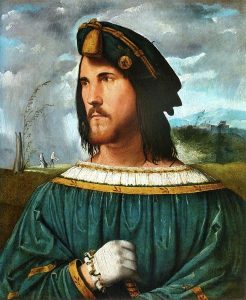
Portrait of a Gentleman (said to be Cesare Borgia) by Altobello Melone
Cesare hired an engineer to help him storm the small state strongholds, someone called Leonardo da Vinci. Cesare gets the pox, (thought to have been brought over from America) and his behaviour deteriorates. He dies from malaria.
The Pope died at the age of 72, also dies after a bout of malarial fever.
The Church blamed its corrupt influence on the Borgias, the succeeding Pope Julius II had their apartments closed off to the public. They were only reopened in the nineteenth century.
